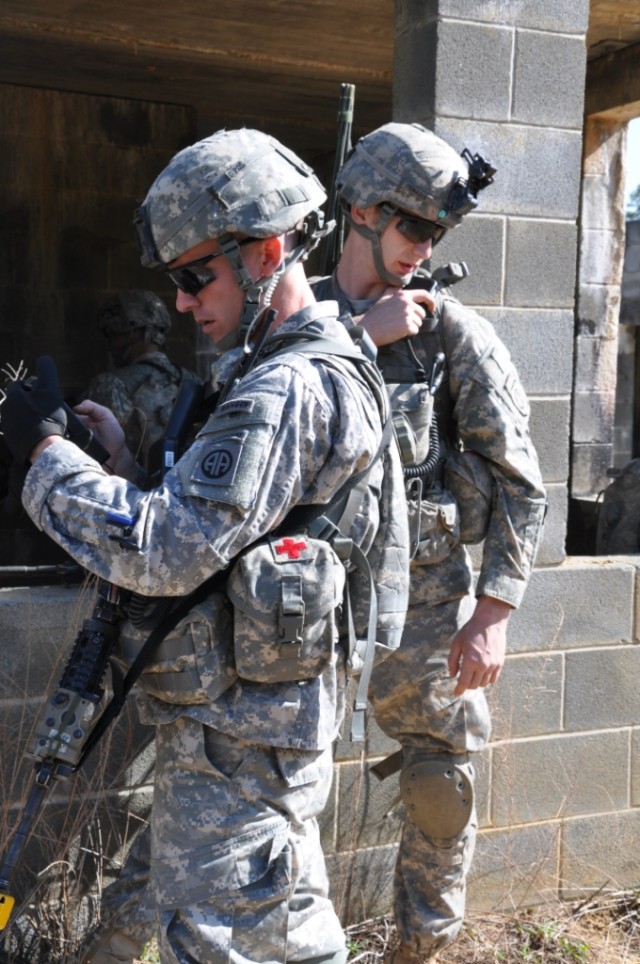FORT BRAGG, N.C. (April 18, 2011) -- Leading his team of paratroopers en route to capturing a high-value target, Spc. Hao Bui encountered obstacles - enemies, streets, roadside bombs.
He pulled a smartphone from his uniform and entered the information into an app, immediately transmitting warning graphics to his buddies and higher headquarters.
"If we see an enemy up front, we could put it in the GPS system," said Bui, a member of the 3rd Brigade Combat Team of the 82nd Airborne Division. "Even though they (fellow Soldiers) can't see it, you can mark it for them."
The device, known as a Joint Battle Command-Platform, or JBC-P Handheld, is the first developed under an Army effort to devise an Android-based smartphone framework and suite of applications for tactical operations. The government-owned framework, known as Mobile /Handheld Computing Environment, or CE, ensures that regardless of who develops them, applications will be secure and interoperable with existing mission command systems so information flows seamlessly across all echelons of the force.
This framework, originally prototyped by MITRE, is now being developed at the Software Engineering Directorate in Huntsville, Ala., with the JBC-P family of systems and is aligned with the Assistant Secretary of the Army for Acquisition, Logistics and Technology Common Operating Environment, or COE strategy.
"Using the Mobile /Handheld CE Product Developers Kit, we're going to allow the third-party developers to actually develop capabilities that aren't stovepiped," said Lt. Col. Mark Daniels, product manager for JBC-P. JBC-P, which will be fielded to both the Army and the Marine Corps beginning in fiscal year 2013, is the follow-on program of record for Force XXI Battle Command Brigade and Below/Blue Force Tracking, or FBCB2/BFT.
"That's going to allow us to be interoperable across the entire family of systems of JBC-P, which would include the platforms, the aviation, the logistics community, the tanks, the Bradleys, the handhelds," Daniels said.
The Mobile /Handheld CE development kit will be released to industry in July, he said. In the interim the Army is refining the Mission Command Apps, which will include mapping, blue force tracking, Tactical Ground Reporting, or TIGR tactical graphics and critical messaging (such as SPOT reports, Medevac and Mayday) between all mission command systems. The baseline suite of applications will also include supporting apps like an address book and Open Office for document viewing.
"It's like when you get an iPhone and you have the Apple-made apps: the contacts, the e-mail," said J. Tyler Barton, an engineer with one of the Army organizations designing apps, the Research, Development and Engineering Command's communications-electronics center Command and Control Directorate. "Then other applications are free to use those apps, or to go above and beyond that."
Allowing industry to freely develop apps within a government-led software environment means the Army can leverage fresh ideas and technology while still maintaining "disciplined" governance, Daniels said.
"All of the research dollars are out there in the commercial market. All of the best minds are at work in these companies to produce these smartphones and this software," Daniels said. "We don't want to rehash that, we want to leverage it. We want to take advantage of it and get it out to the Soldier in a structured fashion, so it can be implemented in a way that is secure and useful at the same time."
For the JBC-P Handheld smartphones themselves, the Army is currently evaluating prototypes to determine whether to use a government-off-the-shelf model or a commercial-off-the-shelf model in a ruggedized tactical sleeve or case. However, the software is being designed so it can run on a variety of different Android platforms.
"We're trying to set this program up so that it can rapidly adapt and maintain relevance to the current warfighting generation," Daniels said.
That flexibility also extends to communications. The JBC-P Handhelds will work over different types of radio networks, including the Joint Tactical Radio System, or JTRS Soldier Radio Waveform, Netted Iridium, and Marine Corps radios such as the PRC 117G and PRC 152A. Even when connected to a radio, the lightweight system weighs approximately two pounds.
Soldiers from the 2nd Brigade, 1St Armored Division will try out the handhelds and JBC-P software during the Network Integration Rehearsal at White Sands Missile Range, N.M., in October. The Network Integration Rehearsal is part of a series of four events leading to executing a fully integrated Brigade Combat Team Network Evaluation at the end of 2012.
For dismounted Soldiers like Bui, the software approach consistent with modern day commercial technology will also provide a consistent, easy-to-use experience. They will be able to choose different Mission Command applications for their specific mission needs without intensive training.
"I was just shown a quick, little, five-minute brief on it - that's all it took and we were ready to use them," said Spc. Randy Fite, who like Bui experimented with the JBC-P Handheld prototype during a recent training exercise at Fort Bragg, N.C. He said the app's blue icons indicating the GPS locations of his fellow Soldiers helped them navigate and coordinate actions during the capture.
"We can know where each unit is in our platoon, and how they're moving," Fite said. "It makes the job a lot easier."
Related Links:
'Digital rodeo' helps Army look at smart-phone apps
Smartphones for all 'makes sense in long run'
Smartphones combine with tactical radios to boost ground troops
Army.mil: Science and Technology News




Social Sharing